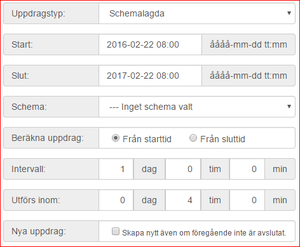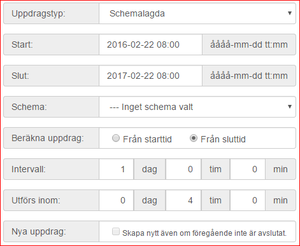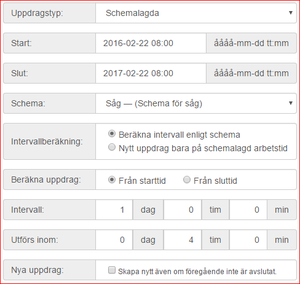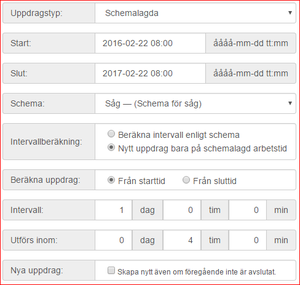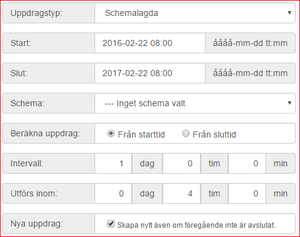Skillnad mellan versioner av "SIDO Administration/en"
Erik (Diskussion | bidrag) (Skapade sidan med 'The difference compared with example 1 is that when the assignment is signed as completed (at 10:00, 22 february) the new assignment will be created in 1 workday (24 workhours...') |
Erik (Diskussion | bidrag) (Skapade sidan med '== Machine == Select the machine to be linked to the assignment.') |
||
| Rad 175: | Rad 175: | ||
|} | |} | ||
| − | == | + | == Machine == |
| − | + | Select the machine to be linked to the assignment. | |
= Kom igång med SIDO = | = Kom igång med SIDO = | ||
Versionen från 7 mars 2016 kl. 13.51
Innehåll
- 1 Machines
- 2 Department/Staff
- 2.1 Roles
- 2.2 Departments
- 2.2.1 Responsible
- 2.2.2 Notification of error reports
- 2.2.3 2-column layout on assignment display
- 2.2.4 Hide completed assignments when new assignment has been created
- 2.2.5 Show number of executed tasks
- 2.2.6 Number of days executed tasks are shown
- 2.2.7 View upcoming assignments
- 2.2.8 Number of days upcoming assignments are shown
- 2.3 Staff
- 3 Workschedule
- 4 Assignment definitions
- 5 Kom igång med SIDO
Machines
The list of machines are the machines that will be available when creating an update.
Department/Staff
Roles
Roles are used to group assignments based on staff roles.
Departments
Departments are used to group assignments based on departments.
The settings in a department also controls to some extent the tasks to be displayed on the assignment display.
Responsible
Sets the overall responsible for a department. This user is created by DataPolarna and will receive their own login to the system. Created error reports are sent to the person responsible for a department.
Notification of error reports
Here you choose how error reports should be notified. Today, only email notification is implemented.
2-column layout on assignment display
This selection lets you choose if the assignment display should be split into two columns or if all assignments should be in the same column.
Hide completed assignments when new assignment has been created
When a scheduled assignment has been completed, a new assignment will be created. If you choose to hide the completed assignment it will be replaced with the new assignment as soon as it gets active. Otherwise, the old assignment will be shown as completed and the new assignment will be shown as active.
Show number of executed tasks
Specifies the number of completed assignments that can be displayed by role or machine. The oldest assignments will be removed first.
Number of days executed tasks are shown
How many days a completed assignment is shown before it is removed from the assignment display.
View upcoming assignments
Select whether or not upcoming assignments should be shown. If selected, upcoming assignments will be shown as inactive (grey) buttons until the assignment is scheduled to start.
Number of days upcoming assignments are shown
How many days ahead future assignments will start showing.
Staff
This is a list of staff that will be able to complete an assignment. Each person can belong to one or more departments and one or more roles.
The created assignments are linked to a department and role.
Workschedule
A work schedule describes the times that are work time, and the times that no work is carried out.
When creating an assignment, you can link it to a work schedule so that the intervals are based on actual work time rather than calendar time.
If you, for example, specifies that an assignment should be repeated with 1 day (24 hours) intervals and do not select a work schedule, the assignment will be repeated every day. If you link the assignment to a work schedule where you have 8 hours of working time per day, the assignment will instead be repeated every third day (8 hours * 3 = 24 hours).
Assignment definitions
The assignment definitions control when and how an assignment should be displayed.
Name
The name is what will appear on the button on the assignment display. Try to write as concisely as possible so that the text will fit on the button.
Description
The description is displayed when you have clicked the assignment button. In addition to plain text, you can also add links and attachments.
Department
Select the department to be linked to this assignment.
Role
Select the role to be linked to this assignment.
Responsible
The person responsible will be able to receive a notification when an assignment ca be started and/or when end time has passed.
Personal
If the assignment is personal, the assignment will appear together with the name of the person responsible on the assignment screen. Although the assignment is personal it may be completed by all in the same department.
Substitute
Indicates whether a substitute may complete the assignment.
Note required
Upon completion of an assignment, you can fill in a note filed along with the name of the person that completed the assignment. Normally, this is optional, but if you check this box, you are forced to fill in an entry before you can sign the assignment as completed.
Notify by
Here you can select how an assignment should be notified. For the moment, only email is implemented.
Notify when
Select when to send a notification; when the assignment may be started and / or when the end time has passed.
Assignment types and workschedule
There are three main types of assignments:
- One-time Jobs
- Maintenance/Downtime
- Scheduled
The start time indicates when the first assignment should start (must be in the future). The end time is for how long time the assignment should be created, not how long the assignment is. The length of an assignment, that is, how long time you have left to complete an assignment is given in the field 'Performed in'.
One-time job
A one-time job is performed once. "Start Time" indicates when the assignment can be started and "Carried out within" specifies the time span you have in which to carry out the assignment.
Example
One-time job to start 22/02/2016 08:00 and to be executed within 4 hours. The assignment button on the assignment display will be activated at 08:00 on 22/02/2016. If the assignment has not been signed as completed within four hours the assignment button will turn red, which means that the assignment has been delayed.
Maintenance/Downtime
This type of assignment is only shown when the maintenance button on the assignment display is selected.
These assignments can either be repeated at given intervals based on calendar time or at intervals based on the schedule.
Scheduled
Scheduled assignments are repeated at specified intervals. A new assignment is created as soon as an assignment is signed as completed. The timeframe for new assignments can be calculated in different ways.
|
Exempel 1 – Schemalagd från starttid
|
|
Exempel 2 – Schemalagd från sluttid
|
|
Exempel 3 – Schemalagd med valt arbetsschema
Hade vi istället valt att beräkna uppdrag från sluttid skulle det nya uppdraget ha skapats klockan 10:00 istället. Om vi dessutom antar att man har rast 09:00-09:15 hade det nya uppdraget skapats kl. 10:15. |
|
Exempel 4 – Schemalagd med nytt uppdrag på schemalagd arbetstid I det här fallet kommer nya uppdrag att skapas baserat på kalendertid, men bara om det nya uppdraget hamnar på en schemalagd arbetstid. |
|
Exempel 5 – Nytt uppdrag även om föregående inte är avslutat Normalt sett så skapas bara nya uppdrag när ett uppdrag blir avslutat/kvitterat. Genom att kryssa i rutan ”Nytt uppdrag: Skapa nytt även om föregående inte är avslutat” kommer nya uppdrag att skapas även om föregående uppdrag inte har avslutats. Det här kan leda till att det blir många uppdrag på uppdragsskärmen om man inte kvitterar aktiva uppdrag regelbundet. |
Machine
Select the machine to be linked to the assignment.
Kom igång med SIDO
Börja med att kontrollera följande:
- Du behöver minst två olika inloggningar, en för att administrera SIDO (lägga in maskiner, avdelningar, personal, uppdrag, mm.) och en användare som används för att visa uppdragen (Har man flera avdelningar kan man sätta upp en användare per avdelning som gör det möjligt att visa bara den avdelningens uppdrag på en skärm och en annan avdelnings uppdrag på en annan skärm). Dessa användare sätts upp av DataPolarna.
Här följer en steg-för-steg lista med saker att tänka på för att så smidigt som möjligt komma igång med SIDO. Exemplen här refererar till ett sågverk men går att anpassa till vilken verksamhet som helst.
- Lägg in en eller flera maskiner. Det här är ett sätt att dela upp uppdragen. Exempel: Såg 1, Hyvel 1, Tork 1
- Skapa ett antal olika roller. Rollerna används för att gruppera personalen på en avdelning. Exempel: Sågare, Justerare, Torkare
- Lägg in avdelningar. Uppdragen delas in på avdelningar vilket gör att det är bara uppdrag kopplade till en viss avdelning som visas beroende på vilken användare som har loggat in. Exempel: Sågen, Justerverket, Torken.
På en avdelning finns det ett antal inställningar som definierar hur uppdragen ska visas på uppdragsskärmen. - Lägg in Personal. Varje person kan kopplas till en eller flera roller och avdelningar.
- Om aktuellt, lägg till ett arbetsschema. När man lägger till aktiviteter i schemat är det viktigt i vilken prioriteringsordning de har. En högre prioritering vinner över en lägre.
- Lägg in uppdragsdefinitioner. En uppdragsdefinition beskriver uppdraget, talar om vilken avdelning/roll/maskin den tillhör, när det ska börja, hur ofta det ska göras, mm.
